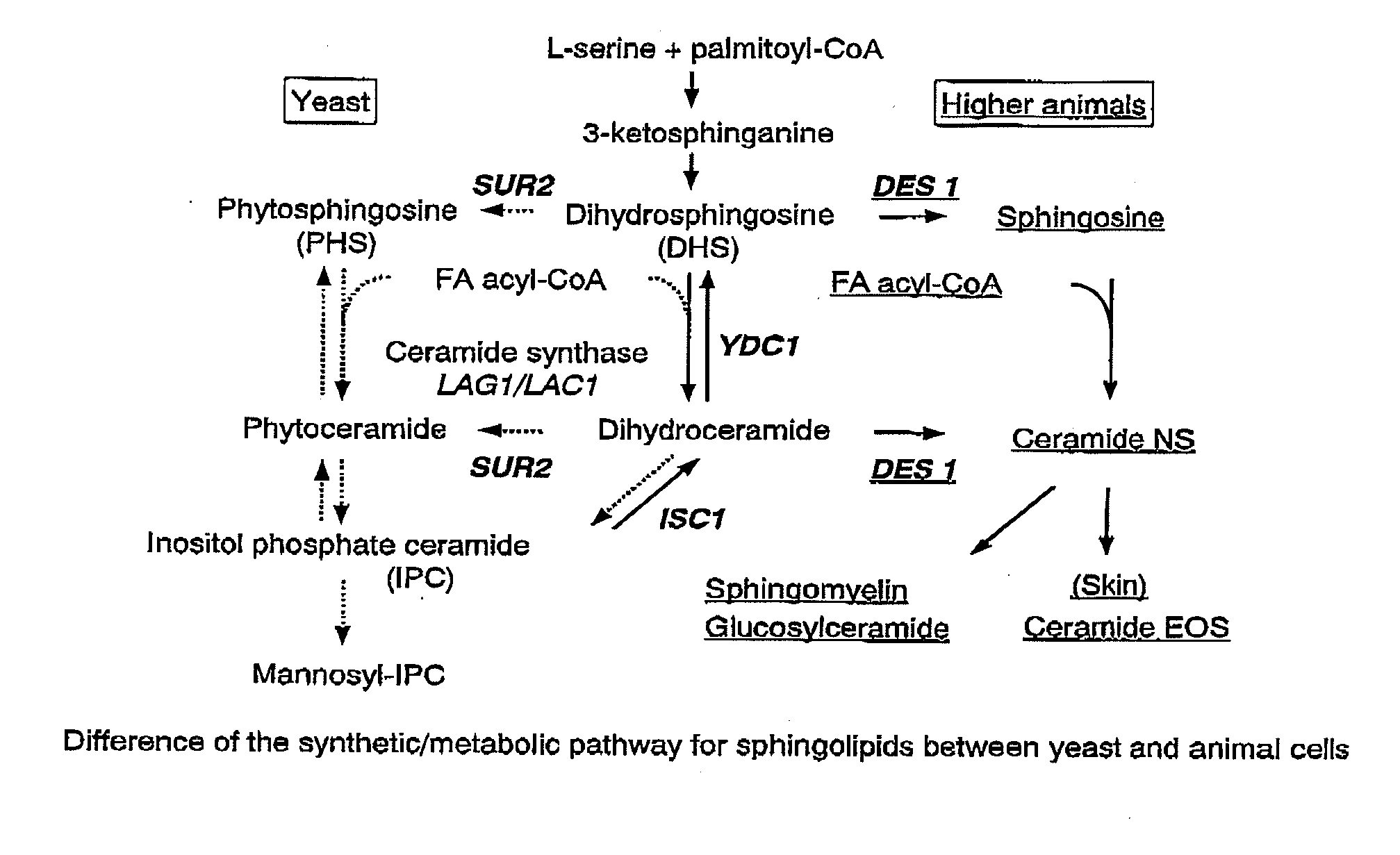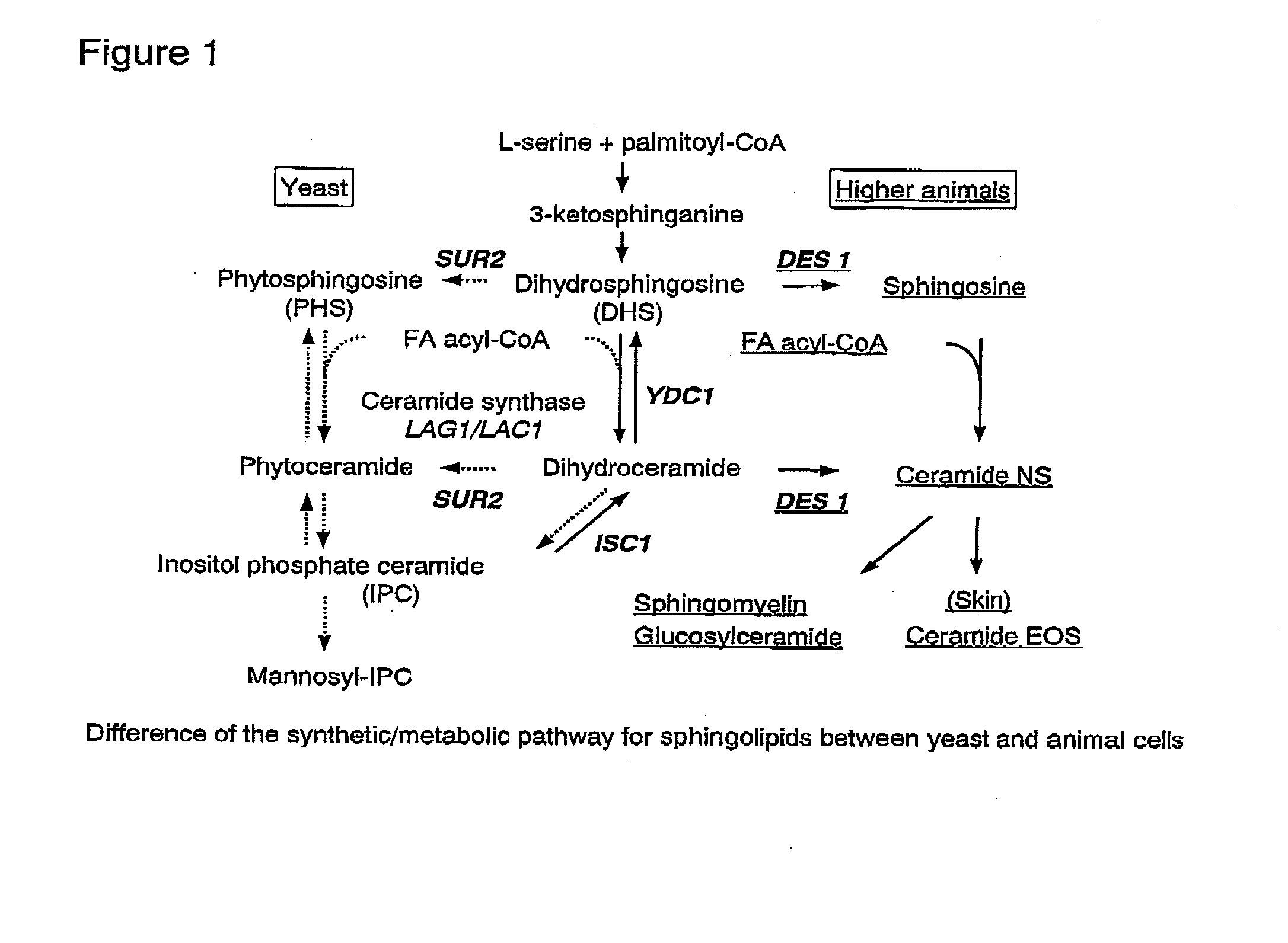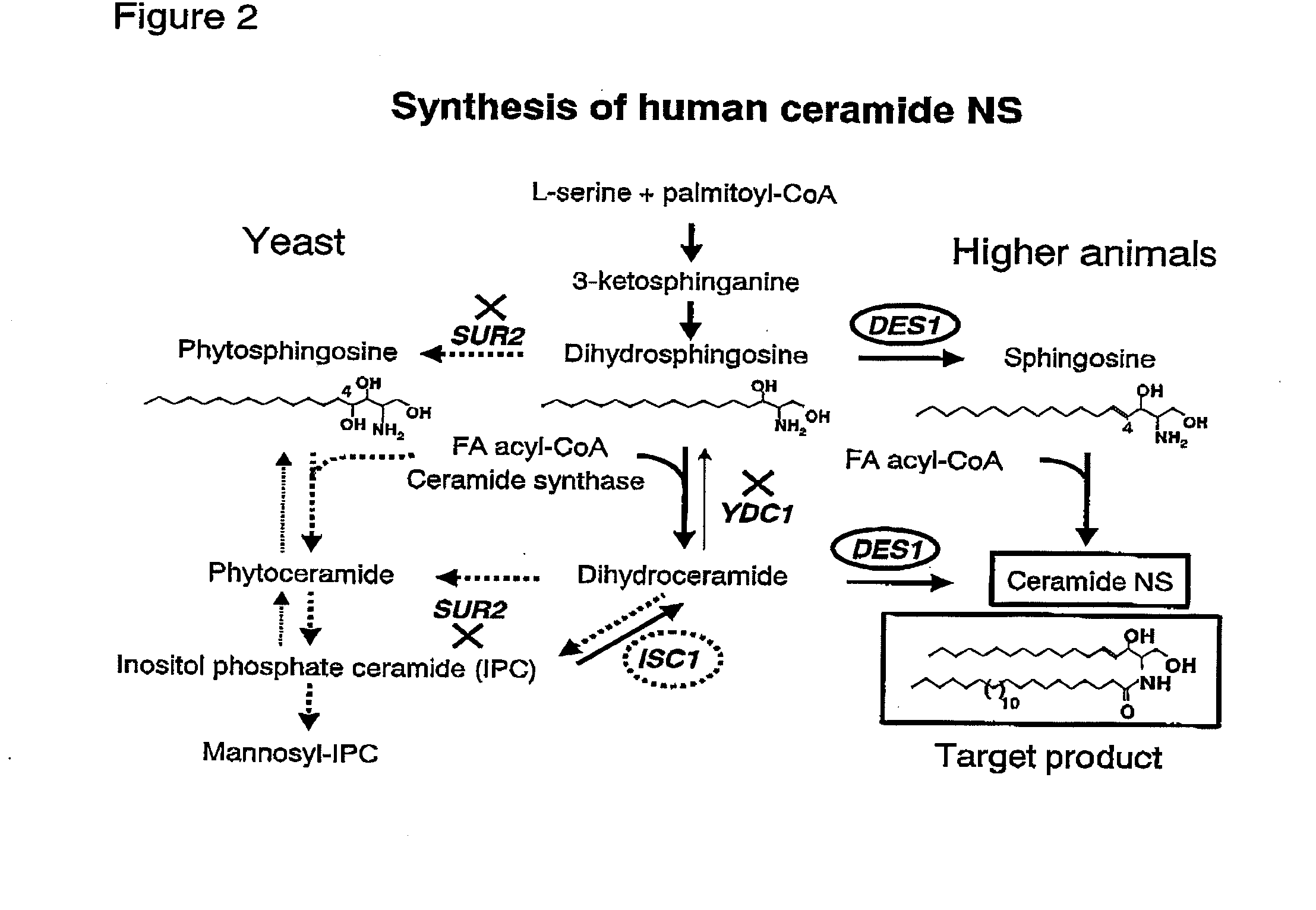Methods for producing ceramide using transformed yeast
a technology of ceramide and yeast, which is applied in the direction of recombinant dna-technology, fertilization, etc., can solve the problems of reducing ceramide levels, affecting the moisturizing ability, and affecting the quality of ceramide, and achieves the effect of high functionality and inexpensive production
- Summary
- Abstract
- Description
- Claims
- Application Information
AI Technical Summary
Benefits of technology
Problems solved by technology
Method used
Image
Examples
example 1
Preparation of a Vector Expressing the Human Sphingoid Δ4-Desaturase Gene (DES1)
[0164]Based on the nucleotide sequence of the human sphingoid Δ4-desaturase gene (DES1) in a public database (GenBanK™: accession number AF466375) (SEQ ID NO: 1), primers des1F (SEQ ID NO: 11) and des1R (SEQ ID NO: 12) were prepared.
SEQ ID NO: 11:5′-CCTTCTCTAGAGGATCCATGGGGAGCCGCGTCTCGCGGGAAGAC-3′SEQ ID NO: 12:5′-CCTTCGAATTCCCCGGGCCAGGGGAGCTTCTGAGCATCACTGGTC-3′.
[0165]The primer pair was used to perform PCR with a human cDNA library as a template. The resulting PCR product (about 1.1 kb) was cloned into the gene expression vector for yeast pKO11 (Kamei et al., J. Biol. Chem., 273, 28341, 1998; provided by Dr. K. Tanaka) using BamHI and SmaI sites.
[0166]The nucleotide sequence of the clone was determined by the Sanger method to confirm that it was identical to the sequence in the database. The clone was subcloned into the gene expression vector for yeast pRS series (p4XX) (Mumberg et al., Gene, 156, 119, 19...
example 2
Preparation of a Vector Expressing the Yeast (Saccharomyces cerevisiae) Inositol Phosphosphingolipid Phospholipase C Gene (ISC1)
[0167]Based on the nucleotide sequence of the yeast (Saccharomyces cerevisiae) inositol phosphosphingolipld phospholipase C gene (ISC1) in a public yeast genome database (SGD (Saccharomyces Genome Database, http: / / www.yeastgenome.org / )) (SEQ ID NO: 3), primers isc1F (SEQ ID NO: 13) and isc1R (SEQ ID NO: 14) were prepared.
SEQ ID NO 13:5′-ATGTACAACAGAAAAGACAGAGATG-3′SEQ ID NO: 14:5′-AAGGTACCTCATTTCTCGCTCAAGAAAGTT-3′.
[0168]The primer pair was used to perform PCR with a routinely prepared yeast genomic DNA as a template. The resulting PCR product (about 1.4 kb) was cloned into the pCR-BluntII-TOPO vector (Invitrogen), and the nucleotide sequence of the clone was determined by the Sanger method (P. Sanger, Science, 214, 1215, 1981) to confirm that it was identical to the sequence in the database.
[0169]The clone was subcloned into the gene expression vector for y...
example 3
Preparation of a Disruption Strain of the Yeast Sphinganine C4-Hydroxylase Gene (SUR2)
[0170]Based on the nucleotide sequence of the yeast sphinganine C4-hydroxylase gene (SUR2) in a public yeast genome database (SGD (Saccharomyces Genome Database, http: / / www.yeastgenome.org / )) (SEQ ID NO; 5), primers sur2F (SEQ ID NO: 15) and sur2R (SEQ ID NO: 16) were prepared.
SEQ ID NO: 15:5′-CTCCGGCTTCTGCGGTTTTTCTTAGTCTTTCCGCACCAATTTTCACAGGAATTCCCGGGGATCCGG-3′SEQ ID NO: 16:5′-GGATAATAAATACAAACGTGGGAAGTCGGAGACATTGCCTTTACCCAGCAAGCTAGCTTGGCTGCAGG-3′.
[0171]The primer pair was used to perform PCR with the plasmid pYDp-L (Berben et al., Yeast, 7, 475, 1991) as a template, thereby giving a PCR product containing a 295-bp upstream region of the SUR2 gene, a selectable marker and a 75-bp downstream region of the SUR2 gene fused together. This PCR product was transformed into the strain FK113 (MATa, ura3, his3, leu2, lys2, trp1, bar1-1), and the transformants were selected in an auxotrophic medium to give ...
PUM
| Property | Measurement | Unit |
|---|---|---|
| pH | aaaaa | aaaaa |
| Tm | aaaaa | aaaaa |
| pH | aaaaa | aaaaa |
Abstract
Description
Claims
Application Information
 Login to View More
Login to View More - R&D
- Intellectual Property
- Life Sciences
- Materials
- Tech Scout
- Unparalleled Data Quality
- Higher Quality Content
- 60% Fewer Hallucinations
Browse by: Latest US Patents, China's latest patents, Technical Efficacy Thesaurus, Application Domain, Technology Topic, Popular Technical Reports.
© 2025 PatSnap. All rights reserved.Legal|Privacy policy|Modern Slavery Act Transparency Statement|Sitemap|About US| Contact US: help@patsnap.com



